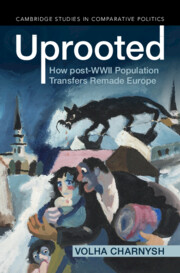Book contents
- Frontmatter
- Contents
- Figures
- Maps
- Tables
- Preface and Acknowledgments
- Abbreviations
- Part I Introduction
- Part II Social Cohesion and Public Goods
- Part III State Building in the Wake of Displacement
- Part IV Long-Run Economic Consequences of Uprooting
- 7 Economic Implications of Diversity in Poland
- 8 Economic Implications of Diversity in West Germany
- 9 Conclusion
- Appendix A Additional Maps, Figures, and Tables
- Appendix B Sources for Archival and Statistical Data
- References
- Index
- Cambridge Studies in Comparative Politics
9 - Conclusion
from Part IV - Long-Run Economic Consequences of Uprooting
Published online by Cambridge University Press: 07 November 2024
- Frontmatter
- Contents
- Figures
- Maps
- Tables
- Preface and Acknowledgments
- Abbreviations
- Part I Introduction
- Part II Social Cohesion and Public Goods
- Part III State Building in the Wake of Displacement
- Part IV Long-Run Economic Consequences of Uprooting
- 7 Economic Implications of Diversity in Poland
- 8 Economic Implications of Diversity in West Germany
- 9 Conclusion
- Appendix A Additional Maps, Figures, and Tables
- Appendix B Sources for Archival and Statistical Data
- References
- Index
- Cambridge Studies in Comparative Politics
Summary
This chapter examines the generalizability of the book’s main argument. It synthesizes the conclusions of other studies on the consequences of three similar episodes of forced migration in the twentieth century: the Greek-Turkish population exchange, the Partition of India, and the repatriation of Pied-Noirs to France. It then considers ways in which the argument can be extended to other cases of forced and voluntary migration.
Keywords
- Type
- Chapter
- Information
- UprootedHow post-WWII Population Transfers Remade Europe, pp. 228 - 238Publisher: Cambridge University PressPrint publication year: 2024

